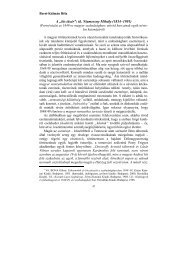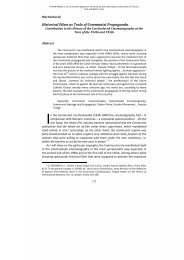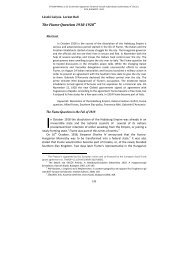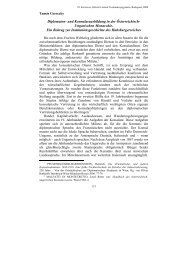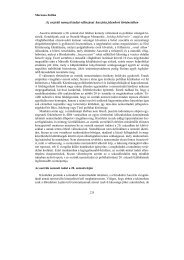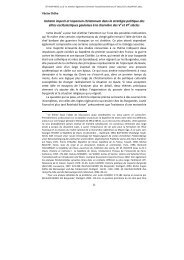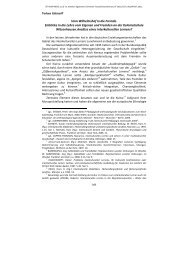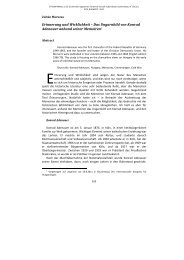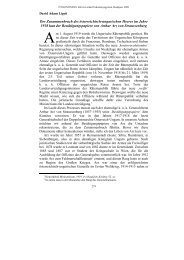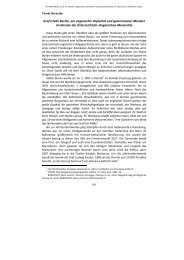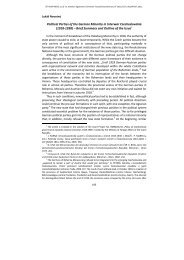The Molotov-Ribbentrop Pact - ELTE BTK Történelem Szakos Portál
The Molotov-Ribbentrop Pact - ELTE BTK Történelem Szakos Portál
The Molotov-Ribbentrop Pact - ELTE BTK Történelem Szakos Portál
Create successful ePaper yourself
Turn your PDF publications into a flip-book with our unique Google optimized e-Paper software.
education. As a matter of fact, the student will exclusively find in his books the<br />
historical events. It’s a history without end and the agreement will be<br />
thoroughly described and explained.<br />
<strong>The</strong> seventies show a break through (the influence of May 1968) in the way<br />
of teaching history. We don’t deal with rooted and hierarchical chapters any<br />
more that encourage continuous reading. Clearly we can observe a wish to find<br />
a balance between the historical facts, the written documents and the<br />
iconography. Even if the documents are kind of weak, especially when it<br />
concerns the <strong>Molotov</strong>-<strong>Ribbentrop</strong> agreement. We can also observe the absence<br />
of a map of Central Europe which is a pity because it would have helped the<br />
student to understand the territorial claims from Hitler and Stalin. <strong>The</strong><br />
presentation of the historical facts has the upper hand. „<strong>The</strong> clear position of<br />
the Soviet Union, the replacement of Litinov, obtained through a co-operation<br />
with the West, by <strong>Molotov</strong>, a very strict interpreter of the Stalin’s realism; does<br />
this mean a change in orientation of soviet’s foreign politics?” 6 .<br />
<strong>The</strong> Soviet Union is at the centre of attention of the European powers. <strong>The</strong>ir<br />
politics stay very ambiguous, an ambiguity that is made very clear in the school<br />
books. <strong>The</strong> soviet foreign politics remain complex, a fact which the school<br />
books have difficulty to define.<br />
In the nineties, we observe a big innovation in the making of school books by<br />
illustrating the facts with documents, made in a way to attract the student. <strong>The</strong><br />
historical facts progressively leave room for written or iconographical illustrations.<br />
<strong>The</strong> secret protocol of the agreement is partially copied in the books. To clarify this<br />
protocol, the school books explain on the one hand the reasons of this treaty or<br />
agreement (the secret protocol) and on the other hand the consequences. But the text<br />
that explains the treaty is briefer than it used to be before and uses a vocabulary also<br />
seen before like „counter nature union” and „the world is stunned”.<br />
<strong>The</strong> educational process evolves, because the student is now asked to make an<br />
intellectual step by using documents. This willingness of showing the treaty<br />
through a different light continues till the years 2000 in which a new program is<br />
made in 2002 and 2007. <strong>The</strong> Nazi-Soviet <strong>Pact</strong> is considered in a more complex<br />
way comparing totalitarianism, fascism, Nazism and Stalinism. <strong>The</strong>ir<br />
resemblances, their dissidences and their expansions have to be explained by the<br />
student. In 2003 new school books appear full of files and close ups explaining on<br />
two pages the historical facts that were important and decisive. <strong>The</strong> two pages<br />
dedicated to the Nazi-Soviet <strong>Pact</strong> are composed of a documentary corpus full of<br />
questions to make students reflect on the event. In 2007 there are two definitions<br />
that illustrate this double page. <strong>The</strong> word pact is „an agreement with mutual<br />
obligations” 7 and the Nazi-Soviet pact is defined as „the signature of August 23,<br />
6<br />
BOUILLON, J et JOHN, A.M. et BRUNEL, F.: Histoire: le monde contemporaine 1914-<br />
1945, manuel de terminale. Bordes, Paris, 1980. 312 à 314.<br />
7<br />
LAMBIN, Jean-Marc: Histoire première ES, L, S. Hachette éducation, Paris, 2007. 294-<br />
295., 316-317.<br />
145



